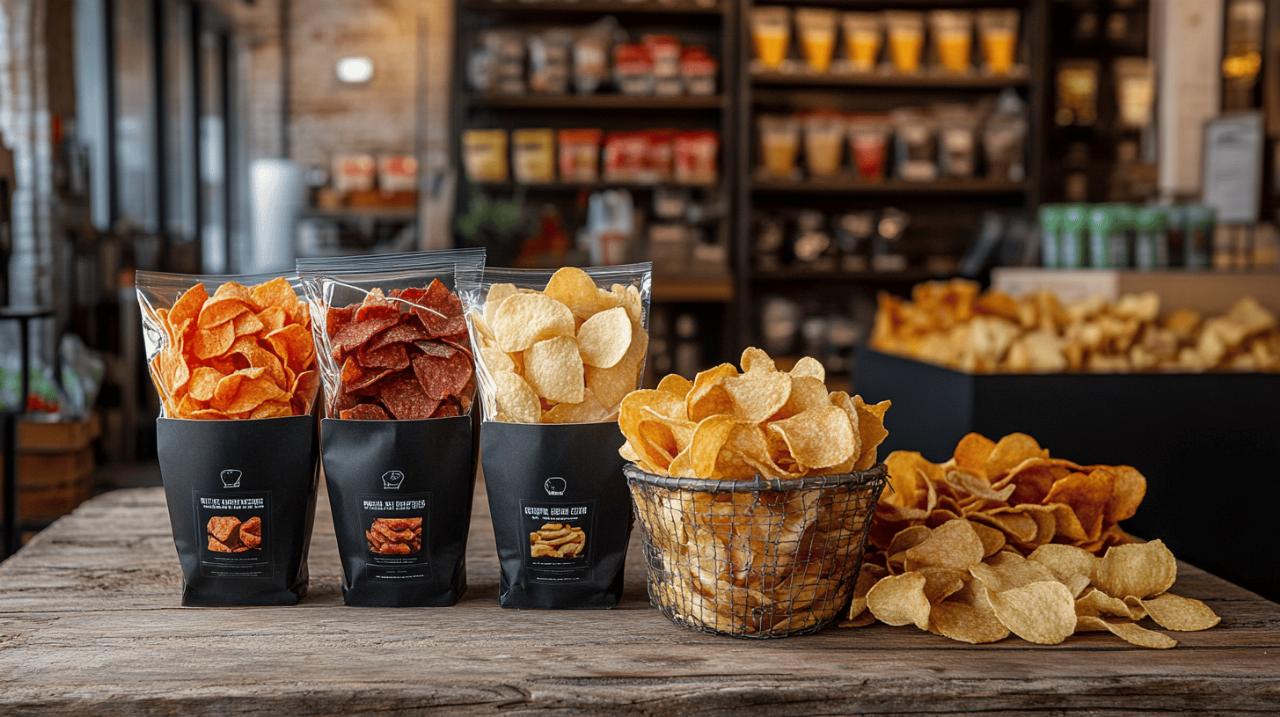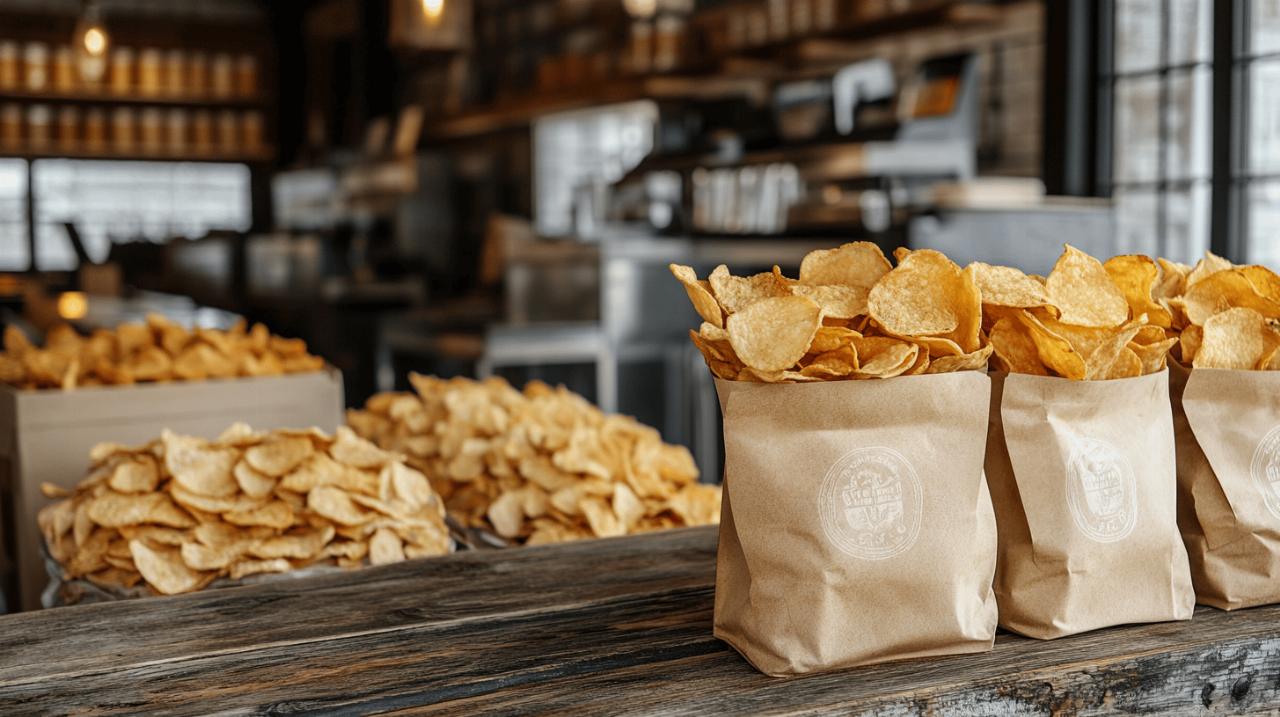The British snack aisle, once dominated by a handful of household names and familiar flavours, has witnessed a remarkable transformation in recent years. Artisanal crisps, with their focus on quality, provenance, and inventive seasonings, have emerged from the margins to claim a significant presence alongside the traditional giants. This shift represents more than a simple expansion of choice; it reflects changing consumer priorities and poses genuine questions about the long-term market positioning of established brands. As shoppers increasingly seek premium experiences even in everyday treats, the rise of these gourmet offerings demands a closer examination of their true impact on market share and the broader competitive landscape.
The artisanal revolution: how premium crisps are reshaping the british snack aisle
From Corner Shop Staple to Gourmet Sensation: The Evolution of the Humble Crisp
The journey of the crisp from a simple, mass-produced snack to a gourmet delicacy is a fascinating tale of consumer empowerment and shifting cultural values. For decades, crisps were seen as a reliable, inexpensive pleasure, a staple found in every corner shop and supermarket across the nation. Brands like Golden Wonder, which launched its Ready Salted variant in 1961 and Cheese & Onion the following year, established the template for what a crisp should be: affordable, consistent, and widely available. However, as the twenty-first century progressed, a growing segment of British consumers began to seek something more from their snacking. They wanted crisps that told a story, that connected them to the land and the producer, and that offered a sensory experience beyond the predictable. This desire for authenticity and quality paved the way for a new generation of small-batch producers who prioritised craftsmanship over volume. These artisans began experimenting with heritage potato varieties, sourcing produce from specific farms, and developing flavour profiles that ranged from delicate sea salt harvested from coastal waters to bold combinations featuring truffle, chorizo, or even wild garlic. The result was a crisp that commanded attention, transforming a mundane snack into a conversation starter and a marker of discerning taste. This evolution has not occurred in isolation; it is part of a broader trend towards premiumisation across the food industry, where consumers are willing to pay more for products they perceive as superior in quality and ethics. The humble crisp, in this context, has become a canvas for innovation and a symbol of the modern consumer's desire for both indulgence and authenticity.
Small-batch production and quality ingredients: what sets artisanal crisps apart
The defining characteristic of artisanal crisps lies in their production methods and the meticulous selection of raw materials. Unlike their mass-produced counterparts, which are manufactured in vast quantities using highly automated processes, artisanal crisps are typically hand-cooked in small batches. This approach allows producers to exercise greater control over every stage of the process, from peeling and slicing the potatoes to monitoring the temperature and duration of frying. The result is a crisp that often has a more irregular shape, a heartier texture, and a more pronounced flavour. The choice of potatoes itself is critical. Many artisanal producers favour locally sourced varieties, sometimes even working with specific farms to cultivate potatoes with particular characteristics suited to crisping. This focus on provenance not only supports local agriculture but also allows for a level of traceability that appeals to consumers increasingly concerned about where their food comes from. Beyond the potatoes, the cooking oil and seasonings are equally important. Some producers use traditional methods, frying in beef dripping for a richer, more robust taste, while others opt for sunflower or rapeseed oil. The seasonings themselves are often crafted from natural ingredients, avoiding artificial flavourings and additives. Sea salt, sourced from British coastlines, is a common choice, as are herbs, spices, and other natural flavourings. This commitment to quality ingredients inevitably comes at a cost, contributing to the higher price point of artisanal crisps compared to standard brands. However, for many consumers, this premium is justified by the superior taste, the ethical sourcing practices, and the overall experience of enjoying a truly special snack. The attention to detail and the emphasis on craftsmanship are what elevate artisanal crisps from a simple snack to a gourmet product, and it is this distinction that has allowed them to carve out a valuable niche in the market.
Market Dynamics and Financial Implications: Measuring the True Impact on Traditional Brands
Sales Figures and Market Share: Are the Big Manufacturers Feeling the Pinch?
The crisps, snacks, and nuts category in the United Kingdom represents a substantial market, valued at approximately five point three billion pounds, with savoury snacks alone generating around six billion pounds annually and demonstrating a growth rate of three point three per cent. Within this thriving sector, the emergence of artisanal crisps has introduced a dynamic element that is reshaping the competitive landscape. While traditional manufacturers still command the lion's share of sales volume, the artisanal segment is growing at a faster rate, driven by consumer demand for premium products. This growth is not merely about adding new products to the shelf; it is about capturing a specific demographic willing to pay more for perceived quality and ethical considerations. The impact on traditional brands is multifaceted. On one hand, the overall category is expanding, which suggests that artisanal crisps are attracting new consumers or encouraging existing ones to snack more frequently. On the other hand, there is evidence that some consumers are trading up, switching from standard crisps to artisanal options, which does represent a direct loss of market share for the big manufacturers. The situation is further complicated by the response of these traditional brands, many of which have launched their own premium or gourmet lines to compete. This strategy allows them to retain customers who might otherwise switch to artisanal brands, but it also risks cannibalising their own core products. The data suggests that retailers who optimise their snack sections, ensuring correct layout and product visibility, can boost sales by around sixteen per cent, which underscores the importance of shelf space and presentation in this competitive environment. The success of Golden Wonder, which saw sales increase by twenty-two per cent by maintaining a price point of one pound, demonstrates that affordability remains a key factor for a significant segment of consumers. However, this does not negate the growing influence of artisanal brands, which are capturing the attention and wallets of a more affluent and discerning consumer base. The overall picture is one of a market in transition, where traditional manufacturers are being challenged to innovate and adapt, while artisanal producers are capitalising on a desire for quality and authenticity.
The Cost of Going Premium: Production Economics and Pricing Strategies in the Artisanal Sector
The economics of artisanal crisp production are fundamentally different from those of mass manufacturing, and these differences are reflected in the pricing strategies adopted by smaller producers. Small-batch production inherently lacks the economies of scale that allow large manufacturers to keep costs down. Every stage of the process, from sourcing potatoes to packaging the final product, is more expensive per unit when done on a smaller scale. The commitment to using locally sourced, high-quality ingredients adds another layer of cost. Premium potatoes, natural seasonings, and cooking oils that meet specific ethical or environmental standards all command higher prices than their mass-produced equivalents. Labour costs are also a significant factor. Artisanal production often involves more manual handling and closer oversight, requiring skilled workers who are paid accordingly. Packaging, too, can be more elaborate and expensive, often featuring premium materials and detailed branding that communicates the product's artisanal credentials. All these factors contribute to the higher retail price of artisanal crisps, which can be two or three times that of standard brands. However, it is important to note that these higher prices are not simply a markup; they reflect the genuine costs of producing a superior product. For the consumer, the question becomes one of value. Are they willing to pay more for a crisp that is made with better ingredients, produced in a more sustainable manner, and offers a more distinctive taste? The answer, for a growing segment of the market, is yes. This willingness to pay a premium is driven by a combination of factors, including a desire for quality, an interest in supporting local producers, and a belief that more expensive products are inherently better. It is also worth noting that the artisanal sector is not monolithic; there is a range of pricing strategies, with some brands positioning themselves at the very top of the market, while others aim for a more accessible premium. This diversity allows artisanal crisps to appeal to a broad spectrum of consumers, from those seeking an occasional indulgence to those who make them a regular part of their snacking routine. The key to success in this sector lies in clearly communicating the value proposition, ensuring that consumers understand what they are paying for and why it is worth the extra outlay.
External Pressures and Supply Chain Challenges: The Ukraine Conflict and Beyond
Rising raw material costs: how global events are affecting both artisanal and mainstream producers
 The ongoing conflict in Ukraine has had profound and far-reaching consequences for global supply chains, and the food industry, including the crisp sector, has not been immune. Ukraine is a major exporter of sunflower oil, a key ingredient in many crisp recipes, and the disruption to its production and export has led to significant price increases for this commodity. This has affected both artisanal and mainstream producers, forcing them to either absorb the higher costs, which squeezes profit margins, or pass them on to consumers in the form of price rises. The situation is further complicated by broader inflationary pressures and disruptions to other supply chains. The cost of potatoes, while generally more stable than sunflower oil, has also been affected by factors such as adverse weather conditions and increased input costs for farmers, including fertiliser and fuel. These rising raw material costs present a particular challenge for artisanal producers, who often operate on tighter margins than large manufacturers. While they may have some flexibility in sourcing ingredients locally, which can insulate them from some global price fluctuations, they are still vulnerable to broader inflationary trends. For mainstream producers, the scale of their operations provides some buffering capacity, but they too are facing pressure to maintain profitability in the face of rising costs. The response from both sectors has varied. Some have opted to absorb a portion of the increased costs, accepting lower profit margins in the short term to avoid alienating price-sensitive consumers. Others have implemented price increases, often accompanied by efforts to communicate the reasons for these rises to consumers. The situation underscores the interconnectedness of global markets and the vulnerability of even seemingly domestic industries to international events. The long-term impact of the Ukraine conflict on the crisp market remains uncertain, but it is clear that rising raw material costs are a significant challenge that will continue to shape the competitive landscape and influence pricing strategies across both the artisanal and mainstream segments.
The ongoing conflict in Ukraine has had profound and far-reaching consequences for global supply chains, and the food industry, including the crisp sector, has not been immune. Ukraine is a major exporter of sunflower oil, a key ingredient in many crisp recipes, and the disruption to its production and export has led to significant price increases for this commodity. This has affected both artisanal and mainstream producers, forcing them to either absorb the higher costs, which squeezes profit margins, or pass them on to consumers in the form of price rises. The situation is further complicated by broader inflationary pressures and disruptions to other supply chains. The cost of potatoes, while generally more stable than sunflower oil, has also been affected by factors such as adverse weather conditions and increased input costs for farmers, including fertiliser and fuel. These rising raw material costs present a particular challenge for artisanal producers, who often operate on tighter margins than large manufacturers. While they may have some flexibility in sourcing ingredients locally, which can insulate them from some global price fluctuations, they are still vulnerable to broader inflationary trends. For mainstream producers, the scale of their operations provides some buffering capacity, but they too are facing pressure to maintain profitability in the face of rising costs. The response from both sectors has varied. Some have opted to absorb a portion of the increased costs, accepting lower profit margins in the short term to avoid alienating price-sensitive consumers. Others have implemented price increases, often accompanied by efforts to communicate the reasons for these rises to consumers. The situation underscores the interconnectedness of global markets and the vulnerability of even seemingly domestic industries to international events. The long-term impact of the Ukraine conflict on the crisp market remains uncertain, but it is clear that rising raw material costs are a significant challenge that will continue to shape the competitive landscape and influence pricing strategies across both the artisanal and mainstream segments.
Navigating Energy Prices and Transport Costs: The Broader Economic Impact on the Crisp Industry
Beyond the direct impact of raw material costs, the crisp industry is also grappling with broader economic pressures related to energy prices and transport costs. The manufacturing of crisps is an energy-intensive process, requiring significant amounts of power for frying, packaging, and refrigeration. The sharp increase in energy prices, driven by factors including the Ukraine conflict and broader global energy market dynamics, has added substantially to production costs for both artisanal and mainstream producers. For smaller artisanal operations, which may not have the same negotiating power as large corporations, these increases can be particularly burdensome. The challenge is compounded by the fact that energy costs are difficult to predict and can fluctuate significantly over short periods, making it hard for businesses to budget and plan effectively. Transport costs have also risen sharply, driven by increases in fuel prices and logistical challenges related to supply chain disruptions. This affects both the delivery of raw materials to production facilities and the distribution of finished products to retailers. For artisanal producers who pride themselves on sourcing ingredients locally, transport costs may be somewhat lower than for those who rely on national or international supply chains, but they are still affected by rising fuel prices. For mainstream manufacturers, who often operate national or international distribution networks, transport costs represent a significant line item in their overall cost structure. The combined effect of rising energy and transport costs has forced many producers to re-evaluate their operational efficiency and explore ways to reduce their environmental footprint, which often has the added benefit of lowering costs. This includes investing in more energy-efficient equipment, optimising logistics networks, and exploring alternative energy sources. The broader economic impact of these pressures is a more challenging operating environment for all players in the crisp market, with implications for pricing, profitability, and long-term sustainability. The ability to navigate these challenges effectively will be a key determinant of success in the years to come.
Consumer Behaviour and Future Prospects: What's Driving the Appetite for Premium Snacking?
Premiumisation and Local Sourcing: Understanding the Modern British Consumer's Priorities
The rise of artisanal crisps is inextricably linked to broader trends in consumer behaviour, particularly the phenomenon of premiumisation and a growing interest in local sourcing. Premiumisation refers to the tendency of consumers to trade up to higher-quality, more expensive products, even in categories that were once dominated by value and price competition. This trend is evident across many sectors of the food industry, from coffee and chocolate to meat and dairy, and crisps are no exception. British consumers, particularly those in higher income brackets, are increasingly willing to pay more for snacks that they perceive as superior in terms of taste, ingredients, and ethical credentials. This is not simply about conspicuous consumption; it reflects a genuine desire for quality and a belief that spending more can deliver a better experience. Local sourcing is another key driver of the artisanal crisp market. Consumers are increasingly interested in knowing where their food comes from and supporting local producers. This is driven by a combination of factors, including concerns about food miles and environmental sustainability, a desire to support local economies, and a belief that locally produced food is fresher and of higher quality. Artisanal crisp producers often capitalise on this trend by prominently featuring the origin of their ingredients and their connections to local farms. This transparency and traceability appeals to consumers who are increasingly sceptical of mass-produced food and eager to make purchasing decisions that align with their values. The data suggests that around ninety-nine per cent of people in Britain consume savoury snacks, and fifty per cent purchase these snacks from local shops, highlighting the importance of accessibility and convenience in this market. The growth of food-to-go options, which now account for sixteen per cent of the top reasons people visit local shops, further underscores the importance of convenience and the desire for easy, high-quality snacking options. The combination of premiumisation and a focus on local sourcing creates a powerful set of drivers for the artisanal crisp market, positioning these products as a desirable choice for a growing segment of British consumers.
Flavour innovation and perceived health benefits: the trends sustaining artisanal crisp growth
Beyond premiumisation and local sourcing, the sustained growth of artisanal crisps is also fuelled by ongoing flavour innovation and the perceived health benefits associated with these products. Flavour innovation is a critical differentiator in the competitive snack market. While traditional brands have historically relied on a limited range of classic flavours, artisanal producers are constantly experimenting with new and exciting combinations. This includes drawing inspiration from international cuisines, incorporating unusual herbs and spices, and creating seasonal or limited-edition flavours that generate excitement and encourage repeat purchases. The trend towards spicy flavours, which has seen an eight point seven per cent yearly growth in the spicy snack section, is one example of how consumer tastes are evolving and how artisanal producers are responding. The ability to innovate quickly and respond to emerging trends is a key advantage for smaller producers, who are not constrained by the same bureaucratic processes and scale limitations as large corporations. In addition to flavour innovation, the perceived health benefits of artisanal crisps are also playing a role in their popularity. While crisps are generally not considered a health food, artisanal brands often position themselves as a healthier alternative to standard crisps by emphasising the use of natural ingredients, the absence of artificial additives, and the use of healthier cooking methods, such as baking rather than frying. Some brands also promote the use of specific potato varieties that are believed to have nutritional advantages. Whether these claims are always substantiated is debatable, but the perception of artisanal crisps as a healthier option is undoubtedly a factor in their appeal to health-conscious consumers. The broader trend towards healthier snacks, which is evident across the European market where consumers are demanding less sugar, gluten-free options, and natural ingredients, is also supporting the growth of artisanal crisps. This convergence of flavour innovation and perceived health benefits creates a compelling value proposition for consumers who are seeking snacks that are both enjoyable and align with their health and lifestyle goals. As these trends continue to evolve, the artisanal crisp market is well-positioned to maintain its momentum and further challenge the dominance of traditional brands.





